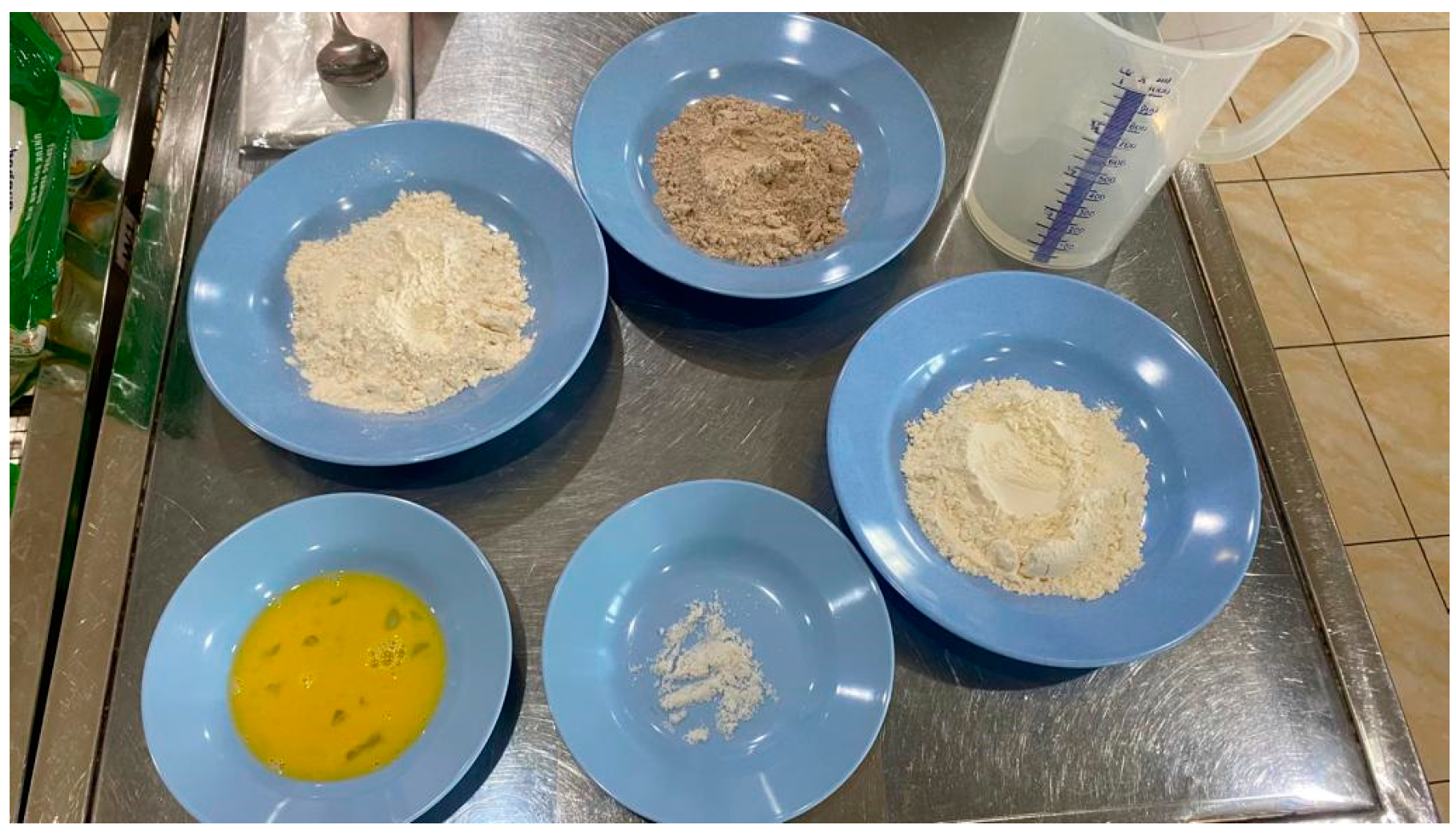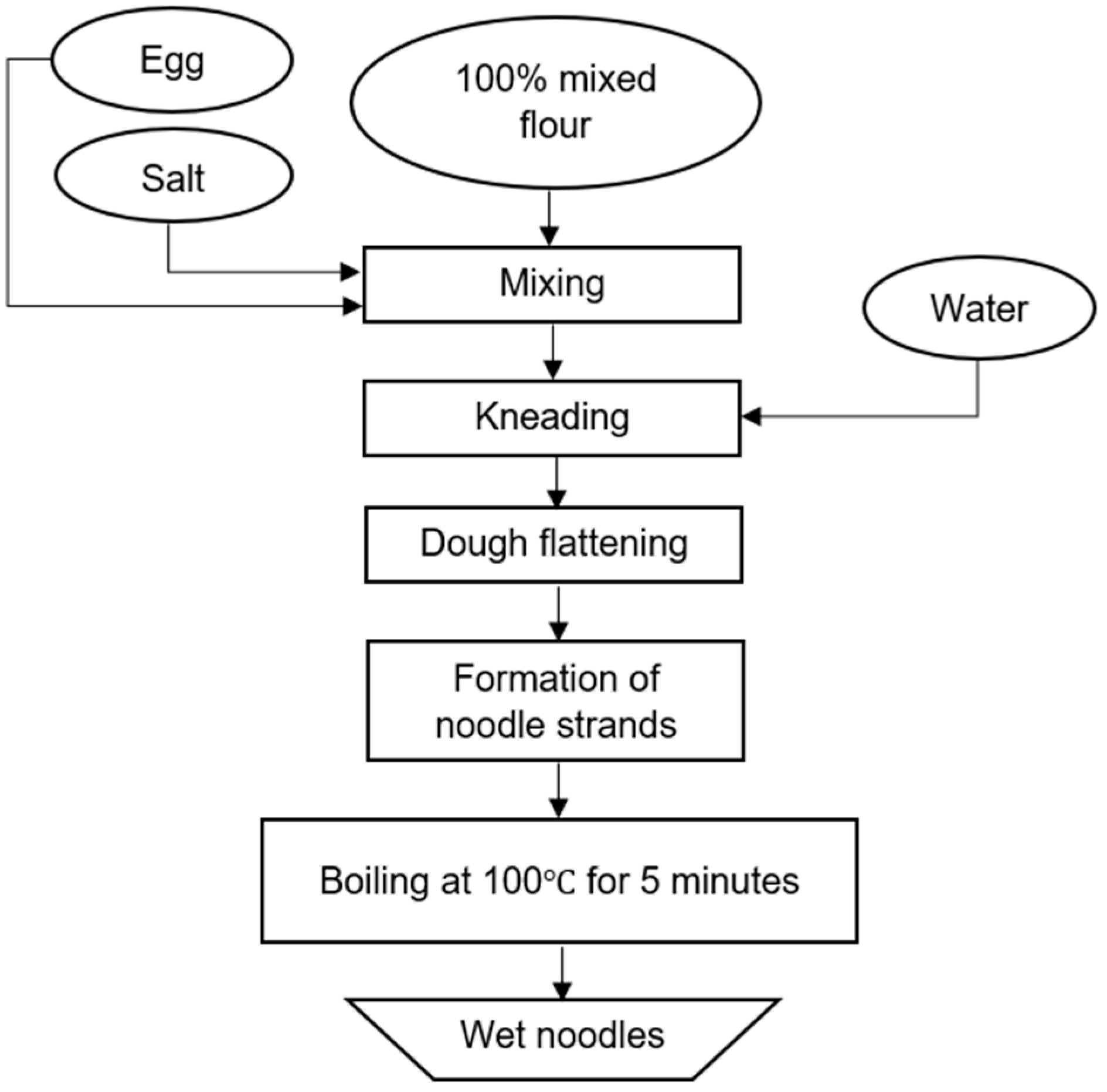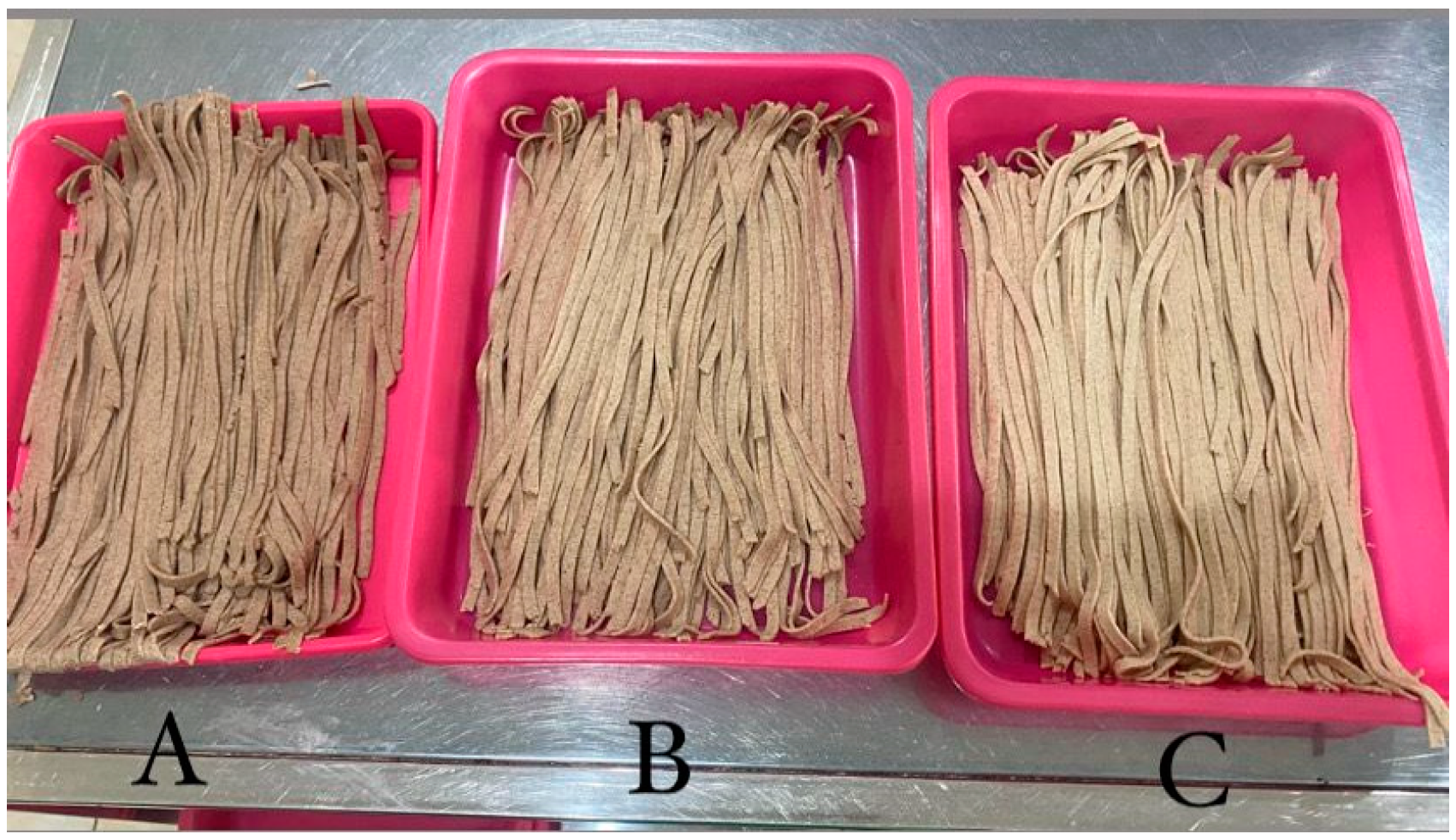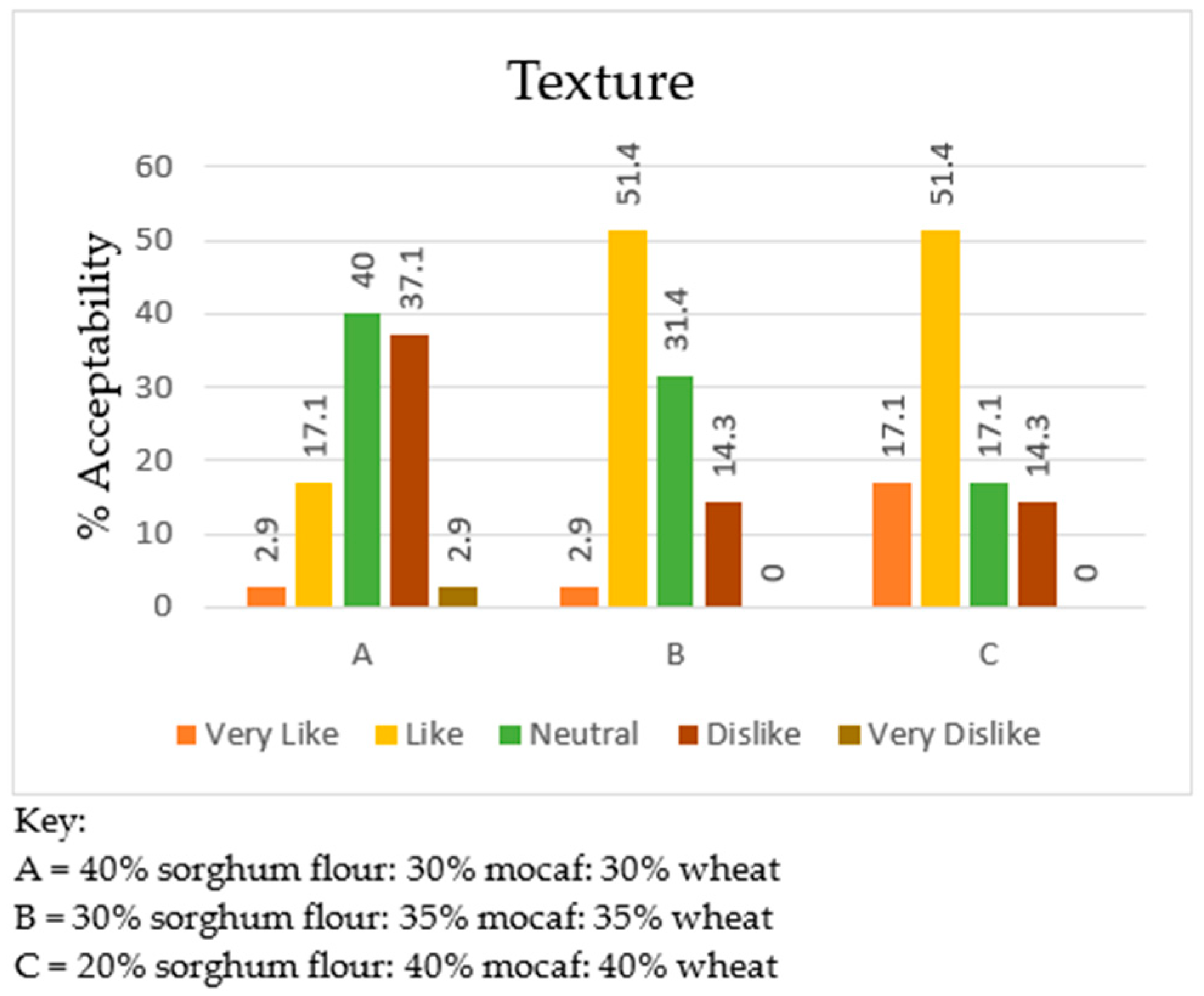The Effect of Composite Flour Composition (Sorghum, Mocaf, and Wheat) on the Elongation, Tensile Strength, and Acceptance of Noodles †
Abstract
1. Introduction
2. Material and Methods
2.1. Tools and Materials
2.2. Procedure for Making Wet Noodles
2.3. Elongation and Tensile Strength Test Procedure
2.4. Acceptability Test Procedure
2.5. Data Analysis
3. Result and Discussion
3.1. Elongation
3.2. Tensile Strength
3.3. Acceptability
3.3.1. Color
3.3.2. Flavor
3.3.3. Aroma
3.3.4. Texture
3.3.5. Overall Acceptability
4. Conclusions
Author Contributions
Funding
Institutional Review Board Statement
Informed Consent Statement
Data Availability Statement
Conflicts of Interest
References
- Kurniawan, A.; Estiasih, T.; Nugrahini, N.I.P. Mie dari Umbi Garut (Maranta arundinacea L.): Kajian Pustaka. J. Pangan Dan Agroindustri 2015, 3, 847–854. [Google Scholar]
- Badan Ketahanan Pangan Kementrian Pertanian. Direktori Perkembangan Konsumsi Pangan; Badan Ketahanan Pangan: Jakarta, Indonesia, 2019; p. 79. [Google Scholar]
- Food and Agriculture Organization of the United Nations. Top 10 Country Importers, Import Quantity of Wheat. Available online: https://www.fao.org/faostat/en/#rankings/countries_by_commodity_imports (accessed on 9 June 2023).
- Triyono, B.; Handoyo, S.; Laili, N. Analysis for Development of Mocaf-Based Functional Food Industry in Indonesia. J. Socioecon. Dev. 2019, 2, 73–87. [Google Scholar] [CrossRef]
- Ramadhan, A.; Sari, E.R. Variasi PerbandinganTepung Terigu dan Mocaf (Modified cassava Flour) Dalam Pembuatan Mie Mocaf. AGRITEPA. 2015, 1, 211–219. [Google Scholar] [CrossRef]
- Rosmeri, V.I.; Monica, B.N. Pemanfaatan Tepung Umbi Gadung (Dioscorea hispida Dennst) dan Tepung Mocaf (Modified cassava Flour) Sebagai Bahan Substitusi dalam Pembuatan Mie Basah, Mie Kering, dan Mie Instan. J. Teknol. Kim. Dan Ind. 2013, 2, 246–256. Available online: https://ejournal3.undip.ac.id/index.php/jtki/article/view/2636 (accessed on 9 June 2023).
- Wanita, Y.P.; Wisnu, E. Pengaruh Cara Pembuatan Mocaf Terhadap Kandungan Amilosa dan Derajat Putih Tepung. In Proceeding Seminar Hasil Penelitian Tanaman Aneka Kacang dan Umbi; Pusat Penelitian dan Pengembangan Tanaman Pangan Badan Penelitian dan Pengembangan Pertanian: Bogor, Indonesia, 2013; pp. 588–596. [Google Scholar]
- Rahim, V.S.; Liputo, S.A.; Maspeke, P.N.S. Sifat Fisikokimia dan Organoleptik Mie Basah dengan Substitusi Tepung Ketan Hitam Termodifikasi Heat Moisture Treatment (HMT). Jambura J. Food Technol. 2021, 3, 42–56. [Google Scholar] [CrossRef]
- Putri, R.M.; Kurnia, P. Pemanfaatan MOCAF (Modified cassava Flour) dengan Sagu (Metroxylon sago Rottb) Terhadap Sifat Elongasi dan Daya Terima Mie Basah. In Proceedings of the 6th University Research Colloquium, Magelang, Indonesia, 9 September 2017; pp. 241–248. [Google Scholar]
- Mustika, A.; Wahyuningsih; Paramita, O. Pengaruh Teknik Perendaman pada Pembuatan Tepung Sorgum Merah (Bicolor L.) Ditinjau dari Kualitas Butter Cookies. Teknobuga 2019, 7, 22–30. [Google Scholar]
- Setyanti, F.; Pranata, F.S.; Purwijantiningsih, L.M.E. Kualitas Muffin Dengan Kombinasi Tepung Sorgum (Sorghum bicolor) dan Tepung Terigu (Triticum aestivum). Undergraduate Thesis, Universitas Atma Jaya Yogyakarta, Yogyakarta, Indonesia, 2015. [Google Scholar]
- Akajiaku, L.O.; Nwosu, J.N.; Kabuo, N.O.; Odimegwu, E.N.; Umelo, M.C.; Unegbu, V.C. Using Sorghum Flour as Part Substitute of Wheat Flour in Noodles Making. MOJ Food Process. Technol. 2017, 5, 250–257. [Google Scholar] [CrossRef][Green Version]
- Fitriani, R.J.; Rauf, R.; Purwani, E. Substitusi Tepung Sorgum Terhadap Elongasi dan Daya Terima Mie Basah dengan Volume Air yang Proporsional. Undergraduate Thesis, Universitas Muhammadiyah Surakarta, Surakarta, Indonesia, 2016. [Google Scholar]
- Obadi, M.; Xu, B. Review on the physicochemical properties, modifications, and applications of starches and its common modified forms used in noodle products. Food Hydrocoll. 2021, 112, 1–25. [Google Scholar] [CrossRef]
- Murdiati, A.; Anggrahini, S.; Supriyanto; Alim, A. Peningkatan Kandungan Protein Mie Basah Dari Tapioka dengan Substitusi Tepung Koro Pedang Putih (Canavalia ensiformis L.). Agritech 2015, 35, 251–260. [Google Scholar] [CrossRef]
- Rosalina, L.; Suyanto, A.; Yusuf, M. Kadar Protein, Elastisitas, dan Mutu Hedonik Mie Basah dengan Substitusi Tepung Ganyong. J. Pangan Dan Gizi 2018, 8, 1–10. [Google Scholar]
- Suryono, C.; Ningrum, L.; Dewi, T.R. Uji Kesukaan dan Organoleptik Terhadap 5 Kemasan Dan Produk Kepulauan Seribu Secara Deskriptif. J. Pariwisata 2018, 5, 95–106. [Google Scholar] [CrossRef][Green Version]
- Darmawan, M.R.; Andreas, P.; Jos, B.; Sumardiono, S. Modifikasi Ubi Kayu Dengan Proses Fermentasi Menggunakan Starter Lactobacillus casei Untuk Produk Pangan. J. Teknol. Kim. Dan Ind. 2013, 2, 137–145. [Google Scholar]
- Biesiekierski, J.R. What is gluten? J. Gastroenterol. Hepatol. 2017, 32, 78–81. [Google Scholar] [CrossRef] [PubMed]
- Ee, K.Y.; Eng, M.K.; Lee, M.L. Physicochemical, Thermal, and Rheological Properties of Commercial Wheat Flours and Corresponding Starches. Food Sci. Technol. 2020, 40, 51–59. [Google Scholar] [CrossRef]
- Prabawa, S.; Zoelnanda, A.; Anam, C. Evaluasi Kualitas Sensoris dan Fisikokimia Mi Basah Sorgum (Sorghum bicolor L. Moench) Sebagai Pangan Fungsional. J. Teknol. Has. Pertan. 2023, 16, 13–28. [Google Scholar] [CrossRef]
- Umri, A.W.; Wikanastri, H. Kadar Protein, Tensile Strength, dan Sifat Organoleptik Mie Basah dengan Substitusi Tepung Mocaf. J. Pangan Dan Gizi 2017, 7, 38–47. [Google Scholar]
- Putra, J.G.; Estiasih, T. Mie dari Umbi Kimpul (Xanthosoma sagittifolium): Kajian Pustaka. J. Pangan Dan Agroindustri 2014, 2, 127–134. [Google Scholar]
- Avif, A.N.; Oktaviana, A. Analisis Sifat Kimia Tepung dan Pati Sorgum dari Varietas Bioguma dan Lokal di Provinsi Nusa Tenggara Timur, Indonesia. Lantanida J. 2020, 8, 96–188. [Google Scholar] [CrossRef]
- Irsalina, R.; Lestari, S.D.; Herpandi, H. Karakteristik Fisiko-Kimia dan Sensori Mie Kering dengan Penambahan Tepung Ikan Motan (Thynnichthys thynnoides). J. FishtecH 2016, 5, 32–42. [Google Scholar] [CrossRef]
- Suarni, S. Peranan Sifat Fisikokimia Sorgum dalam Diversifikasi Pangan dan Industri serta Prospek Pengembangannya. J. Penelit. Pengemb. Pertan. 2016, 35, 99. [Google Scholar] [CrossRef]








| Treatment | Mb I | Mb II | Average Elongation | ||
|---|---|---|---|---|---|
| Repetition 1 (%) | Repetition 2 (%) | Repetition 1 (%) | Repetition 2 (%) | ||
| A (40:30:30) | 8.92 | 8.33 | 6.65 | 5.15 | 7.26 1.71 a |
| B (30:35:35) | 10.45 | 8.48 | 10.92 | 13.11 | 10.74 1.90 b |
| C (20:40:40) | 11.74 | 12.64 | 12.40 | 15.06 | 12.96 1.45 b |
| Sig. | 0.003 | ||||
| Treatment | Mb I | Mb II | Average Tensile Strength (MPa) | ||
|---|---|---|---|---|---|
| Repetition 1 (MPa) | Repetition 2 (MPa) | Repetition 1 (MPa) | Repetition 2 (MPa) | ||
| A (40:30:30) | 0.045 | 0.037 | 0.031 | 0.027 | 0.0078 |
| B (30:35:35) | 0.036 | 0.040 | 0.037 | 0.037 | 0.0017 |
| C (20:40:40) | 0.034 | 0.037 | 0.040 | 0.040 | 0.0029 |
| Sig. | 0.693 | ||||
| Parameters | Average Hedonic Test Score | Sig. | ||
|---|---|---|---|---|
| A (40:30:30) | B (30:35:35) | C (20:40:40) | ||
| Color | 0.808 a | 0.914 a | 0.770 b | 0.000 |
| Flavor | 0.968 a | 0.770 b | 0.664 b | 0.001 |
| Aroma | 0.770 | 0.852 | 0.867 | 0.132 |
| Texture | 0.868 a | 0.778 b | 0.926 b | 0.000 |
| Overall | 0.733 a | 0.702 ab | 0.692 b | 0.000 |
Disclaimer/Publisher’s Note: The statements, opinions and data contained in all publications are solely those of the individual author(s) and contributor(s) and not of MDPI and/or the editor(s). MDPI and/or the editor(s) disclaim responsibility for any injury to people or property resulting from any ideas, methods, instructions or products referred to in the content. |
© 2024 by the authors. Licensee MDPI, Basel, Switzerland. This article is an open access article distributed under the terms and conditions of the Creative Commons Attribution (CC BY) license (https://creativecommons.org/licenses/by/4.0/).
Share and Cite
Prihayati, D.A.; Purwani, E. The Effect of Composite Flour Composition (Sorghum, Mocaf, and Wheat) on the Elongation, Tensile Strength, and Acceptance of Noodles. Eng. Proc. 2024, 63, 17. https://doi.org/10.3390/engproc2024063017
Prihayati DA, Purwani E. The Effect of Composite Flour Composition (Sorghum, Mocaf, and Wheat) on the Elongation, Tensile Strength, and Acceptance of Noodles. Engineering Proceedings. 2024; 63(1):17. https://doi.org/10.3390/engproc2024063017
Chicago/Turabian StylePrihayati, Dina Alviani, and Eni Purwani. 2024. "The Effect of Composite Flour Composition (Sorghum, Mocaf, and Wheat) on the Elongation, Tensile Strength, and Acceptance of Noodles" Engineering Proceedings 63, no. 1: 17. https://doi.org/10.3390/engproc2024063017
APA StylePrihayati, D. A., & Purwani, E. (2024). The Effect of Composite Flour Composition (Sorghum, Mocaf, and Wheat) on the Elongation, Tensile Strength, and Acceptance of Noodles. Engineering Proceedings, 63(1), 17. https://doi.org/10.3390/engproc2024063017





